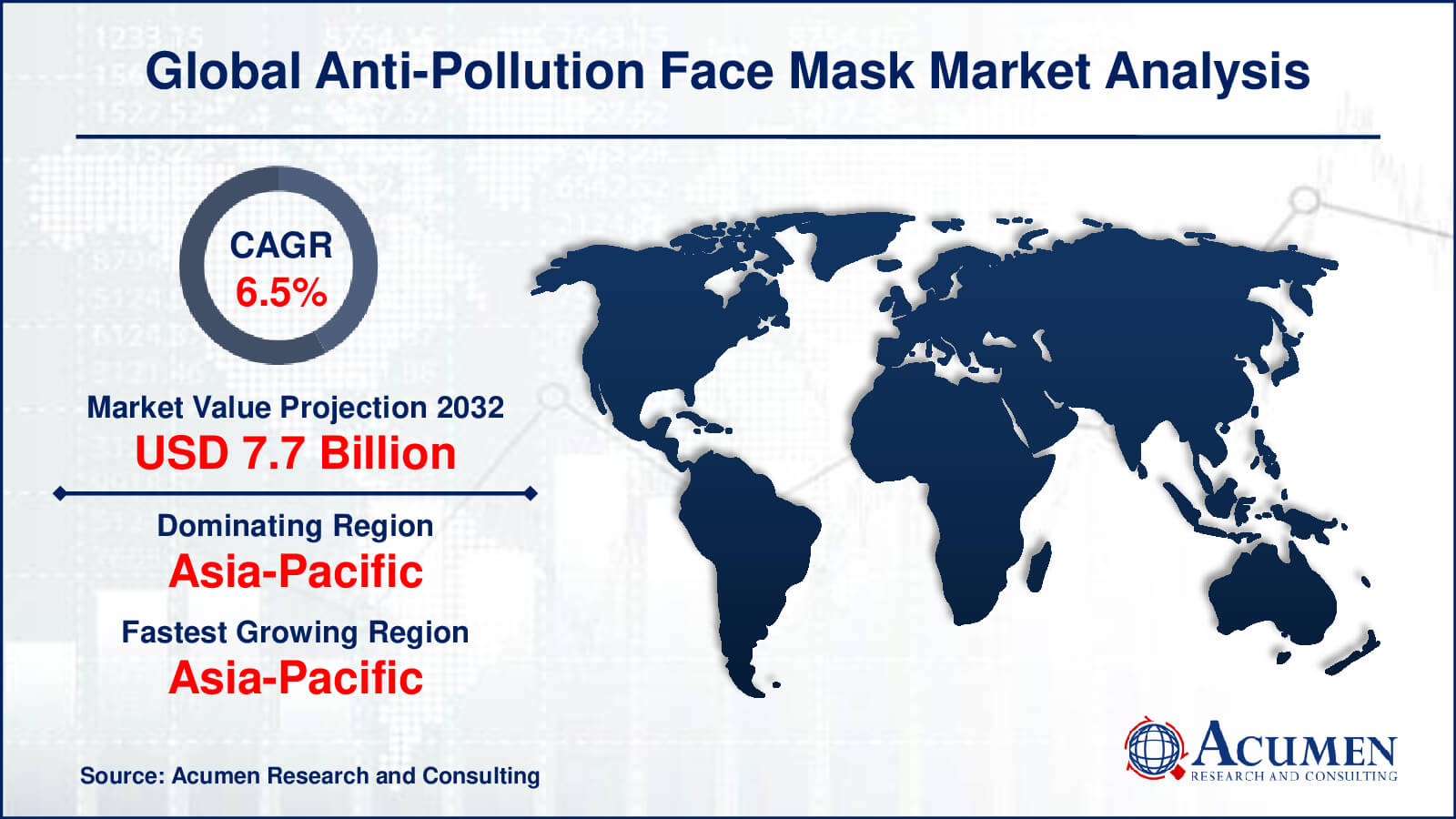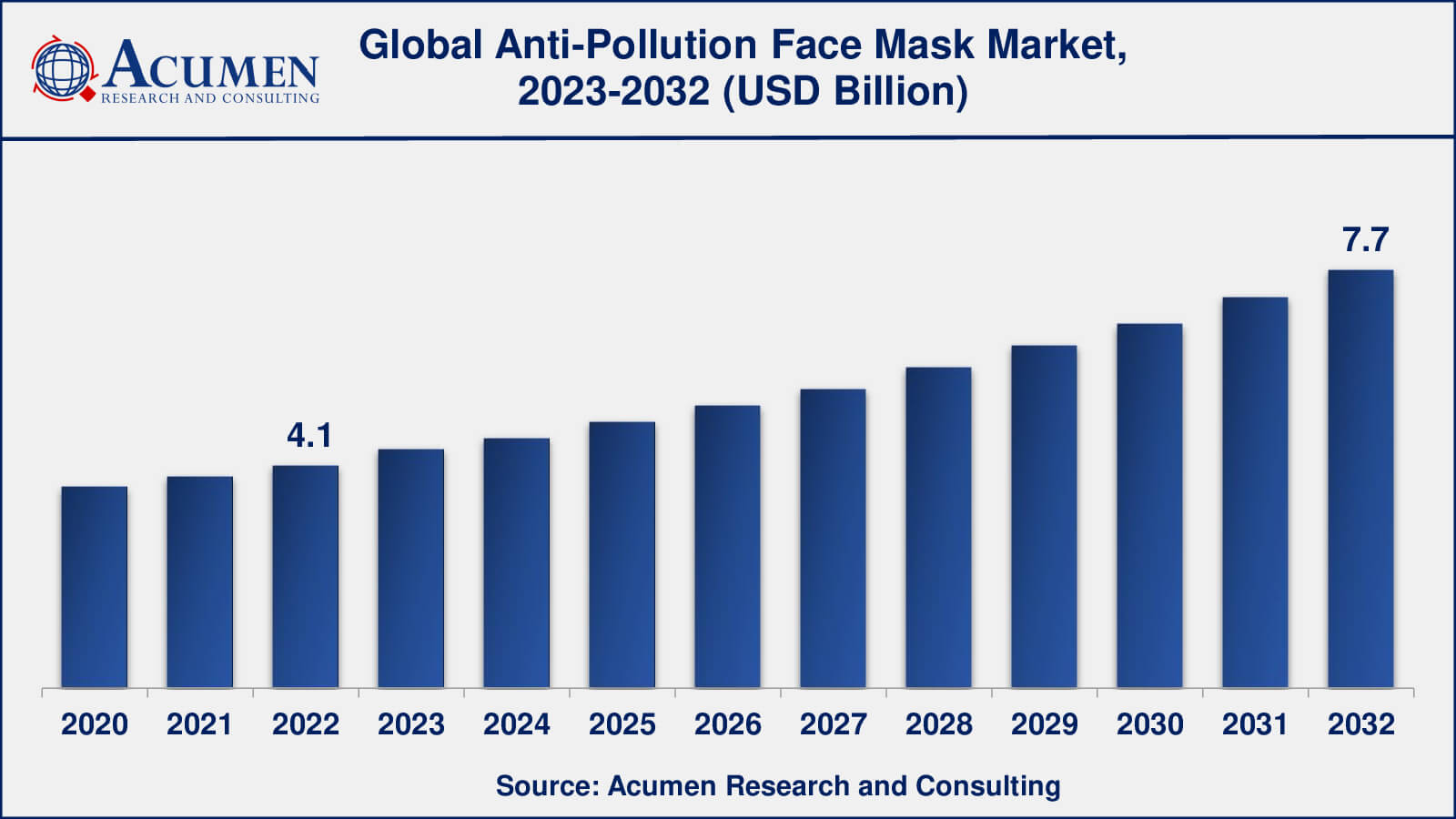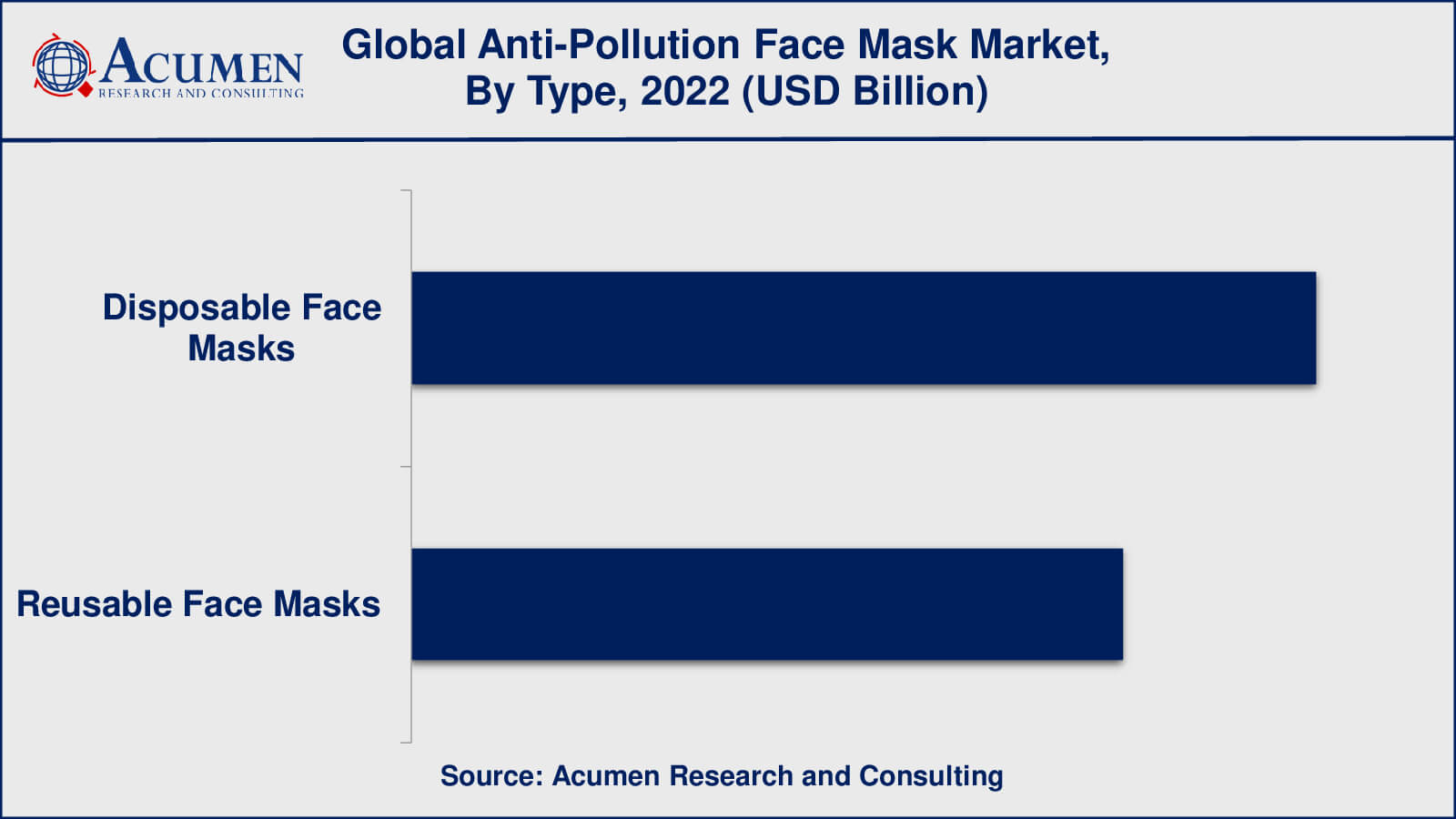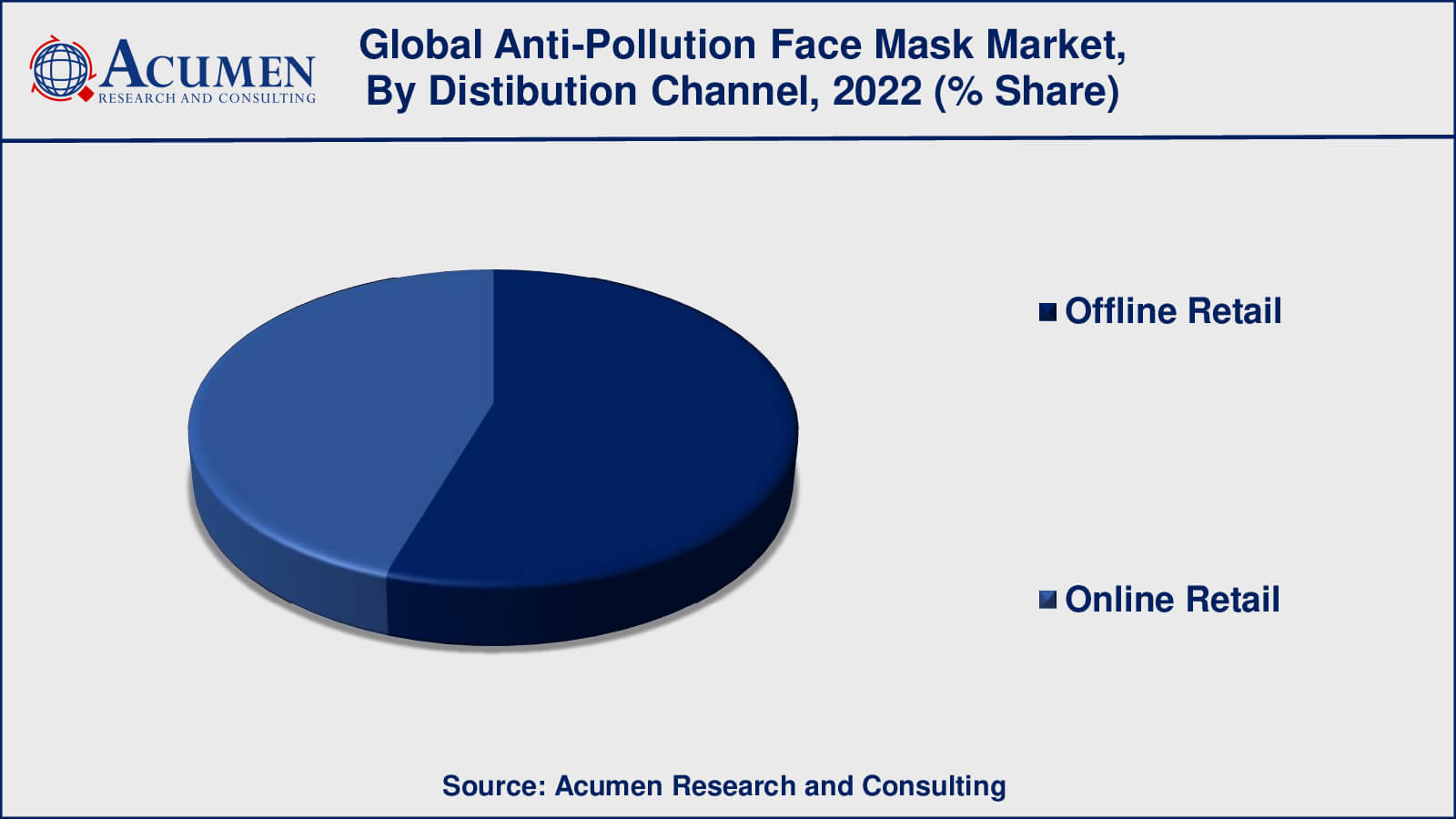March 2025
Anti-Pollution Face Mask Market Size accounted for USD 4.1 Billion in 2022 and is estimated to achieve a market size of USD 7.7 Billion by 2032 growing at a CAGR of 6.5% from 2023 to 2032.
The Global Anti-Pollution Face Mask Market Size accounted for USD 4.1 Billion in 2022 and is estimated to achieve a market size of USD 7.7 Billion by 2032 growing at a CAGR of 6.5% from 2023 to 2032.
Anti-Pollution Face Mask Market Highlights

An anti-pollution face mask is a malleable cushion pad worn over the mouth and nose by rubber or elastic straps to block dust and other foreign particles encountered during cleaning and construction activities, for example, dust from bricks, drywalls, fiberglass, wood, sweeping, or silica. A dust mask is also used to ensure protection against allergens. A dust mask is generally worn in a similar fashion to a surgical mask or a paint mask. Using an inappropriate mask for a specific job can pose a possibly deadly and significant danger since different dust masks with diverse levels of protection might look alike. Misfitting of dust masks may also pose a threat since they might allow the unwanted foreign particle to bypass the mask completely. Dust masks are supplied and used in order to protect against specific dangers and are unable to protect against toxic chemicals such as mists and vapors. Hence, it might be dangerous to confuse and mix paint masks with dust masks. Dust masks are relatively lighter, cheaper, and more comfortable substitutes to respirators but the degree of protection provided by a dust mask can be a bit inefficient and more impressionable to poor fit or any misuse. Various dust masks come with extra advancement and improvements such as upper and lower straps behind the head along with having an aluminum strip on the outer part of the mask across the bridge of the nose to enable bends in order to achieve a custom fit. Dust masks might also have features such as a foam or rubber strip on the inside edge across the nose bridge to enable an accurate seal. Dust masks used by construction workers working around non-poisonous dust must have a seal and note reading N95, as directed by National Institute for Occupational Safety and Health (NIOSH).

Global Anti-Pollution Face Mask Market Dynamics
Market Drivers
Market Restraints
Market Opportunities
Anti-Pollution Face Mask Market Report Coverage
| Market | Anti-Pollution Face Mask Market |
| Anti-Pollution Face Mask Market Size 2022 | USD 4.1 Billion |
| Anti-Pollution Face Mask Market Forecast 2032 | USD 7.7 Billion |
| Anti-Pollution Face Mask Market CAGR During 2023 - 2032 | 6.5% |
| Anti-Pollution Face Mask Market Analysis Period | 2020 - 2032 |
| Anti-Pollution Face Mask Market Base Year | 2022 |
| Anti-Pollution Face Mask Market Forecast Data | 2023 - 2032 |
| Segments Covered | By Type, By Application, By Distribution Channel, And By Geography |
| Regional Scope | North America, Europe, Asia Pacific, Latin America, and Middle East & Africa |
| Key Companies Profiled | Shanghai Dasheng, Honeywell International Inc., Kimberly-Clark, Te Yin, Maskin, Honeywell, Vogmask, Kowa, Respro, Uvex, Totobobo, idMASK Co., Ltd., Hakugen, Dach, and 3M. |
| Report Coverage |
Market Trends, Drivers, Restraints, Competitive Analysis, Player Profiling, Covid-19 Analysis, Regulation Analysis |
Anti-Pollution Face Mask Market Insights
The global anti-pollution face mask market is anticipated to be driven by key factors such as increasing per capita disposable income and rising consumer inclination towards healthy alternatives and pollution-preventive products. Moreover, increasing investments in the advancement of pollution masks by key manufacturers is another major factor leading to the growth of the anti-pollution face masks market, globally. Increasing consumer awareness of a healthy lifestyle is also fueling the growth of the market. Rising government initiatives towards compulsion on the use of face masks as well as an increase in product innovations in the global face mask for anti-pollution is anticipated to accelerate the market growth during the forecast period. Furthermore, increasing consumer spending ability as well as a decrease in costs of anti-pollution face masks are other factors propelling the global face mask for the anti-pollution market. Factors such as risks associated with the materials used in manufacturing anti-pollution face masks as well as issues related to allergy are some of the key challenges hampering the growth of the global anti-pollution face mask market.

Anti-Pollution Face Mask Market Segmentation
The worldwide market for anti-pollution face mask is split based on type, application, distribution channel, and geography.
Anti-Pollution Face Mask Market By Type

According to the anti-pollution face mask industry analysis, disposable face masks are typically made of non-woven materials and are intended for single use only before being discarded. They are frequently preferred due to their convenience and affordability, particularly for those who use them infrequently. During the COVID-19 pandemic, disposable face masks saw an increase in demand, leading to their supremacy in the overall face mask market.
Reusable face masks, on the other hand, are made of long-lasting materials like cotton or polyester and can be washed and reused repeatedly. They are frequently preferred for their environmental friendliness and cost-effectiveness, particularly by people who use them frequently. Reusable face masks are also more environmentally friendly than disposable masks and are becoming more popular as people become more environmentally conscious.
Anti-Pollution Face Mask Market By Application
According to the anti-pollution face mask market forecast, the personal use will dominate the anti-pollution face mask market in the coming years. This can be attributed to increased public awareness of air pollution and growing concern among individuals about the potential health consequences of pollutant exposure. The COVID-19 pandemic has also had an important part in driving demand for personal use face masks, with governments and health organisations all over the world recommending or mandating their use to prevent the virus's spread.
While industrial and healthcare applications for anti-pollution face masks are important markets, personal use has been the biggest and fastest-growing segment in recent years. This pattern is expected to continue as people prioritise their health and safety in the face of public health and environmental challenges.
Anti-Pollution Face Mask Market By Distribution Channel

Anti-pollution face masks are distributed through both online and offline retail channels. In coming years, however, the online retail channel will gain a significant share in the market. This is due to the growing popularity of e-commerce platforms and the ease of online shopping. Online retail channels also offer a wider range of products and enable customers to easily compare prices and product features.
Furthermore, the COVID-19 pandemic has accelerated the growth of online sales, as more people have turned to online shopping to avoid crowds and reduce their risk of virus exposure. While offline retail channels such as specialty stores, pharmacies, and supermarkets continue to play an important role in the distribution of anti-pollution face masks, online retail has surpassed offline retail as the primary channel for many customers, particularly those who prefer the convenience of shopping from home.
Anti-Pollution Face Mask Market Regional Outlook
North America
Europe
Asia-Pacific
Latin America
The Middle East & Africa
Anti-Pollution Face Mask Market Regional Analysis
The Asia-Pacific region has been the major segment for anti-pollution face masks, owing to high levels of air pollution in many of the region's countries. China, India, and Japan are among the region's largest markets, with rising demand also seen in Indonesia, Thailand, and South Korea.
The growing awareness of air pollution and its health consequences is driving the anti-pollution face mask market in Europe. Major markets for these products have included the United Kingdom, Germany, France, and Italy.
Concerns about air pollution and the effects of climate change drive the North American market for anti-pollution face masks. The region's largest markets are the United States and Canada.
Anti-Pollution Face Mask Market Players
Some of the top anti-pollution face mask companies offered in the professional report include Shanghai Dasheng, Honeywell International Inc., Kimberly-Clark, Te Yin, Maskin, Honeywell, Vogmask, Kowa, Respro, Uvex, Totobobo, idMASK Co., Ltd., Hakugen, Dach, and 3M.
Looking for discounts, bulk pricing, or custom solutions? Contact us today at sales@acumenresearchandconsulting.com
March 2025
September 2022
September 2020
July 2024